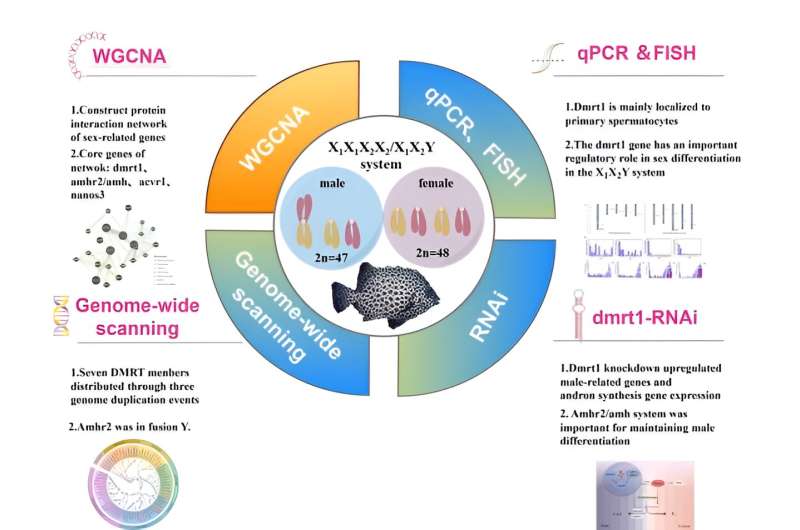This article has been reviewed according to Science X's editorial process and policies. Editors have highlighted the following attributes while ensuring the content's credibility:
fact-checked
trusted source
proofread
Study sheds new light on regulation of sex differentiation in spotted knifejaw, a cultured fish

A new study published in the International Journal of Biological Macromolecules has identified the regulatory mechanism of sex differentiation in the important cultured fish, the spotted knifejaw (X1X1X2X2/X1X2Y).
Previous studies have highlighted the pivotal role of the Doublesex mab-3 related transcription (DMRT) family in male sex determination and differentiation. However, its regulatory role in Oplegnathus punctatus, with a Y-fusion chromosome, remains unclear.
To address the remaining challenge of understanding the determination and differentiation mechanisms of fish in the X1X2Y system, a research team led by Prof. Li Jun from the Institute of Oceanology of the Chinese Academy of Sciences has carried out a comprehensive study on the regulatory mechanism of sex differentiation in spotted knifejaw.
"This involves the integration of female–male whole-genome variation scanning, transcriptome sequencing of the gonads, weighted correlation network analysis (WGCNA) of gonadal development time series, identification and analysis of gene family members, and biological verification experiments such as fluorescence in situ hybridization (FISH) in gonadal cells and RNAi (RNA interference)," said Zhao Haixia, lead author of the study.
The researchers built a database of transcriptome differences in the male and female gonads throughout the developmental stages of the spotted knifejaw. Using WGCNA analysis, they constructed a regulatory network of differentially expressed genes in the X1X1X2X2/X1X2Y complex chromosome system, revealing core genes—dmrt1, amhr2/amh, acvr1, nanos3—that regulate male gonadal development in this species. Whole-genome scanning analysis shed light on seven dmrt gene family members in the spotted knifejaw, namely dmrt1/2 (2a, 2b)/6, dmrt4/5, and dmrt3.
The researchers proposed, for the first time, that the spotted knifejaw had undergone three genome duplication events, based on the chromosomal distribution pattern of the dmrt genes. The whole-genome scanning identified the sex-related gene amhr2 on the fused chromosome (Y). Transcriptome analyses throughout gonadal development, corroborated by qPCR and FISH, validated the significant role of the dmrt1 gene in the sex differentiation of male and female gonads in the spotted knifejaw with the X1X2Y system.
Subsequent experiments using dmrt1 dsRNAi showed that knockdown of dmrt1 not only failed to downregulate the male-related genes, but also significantly upregulated genes closely associated with male differentiation (e.g., sox9a, sox9b, amh, amhr2) and the key gene involved in testosterone synthesis (hsd11b2).
Moreover, the researchers identified another key pathway that promotes male differentiation and maintains testosterone synthesis in spotted knifejaw with theX1X2Y system, in addition to dmrt1, which is closely related to male differentiation.
Intriguingly, targeting dmrt1 resulted in the persistent and efficient expression of the amhr2/amh system localized on the male heteromorphic chromosome Y, and even promoted the expression of the testosterone synthesis gene hsd11b2. This indicates that amhr2 may play an indispensable role in the sex differentiation process of the spotted knifejaw.
"The study reveals for the first time the origin and evolutionary pattern of the DMRT gene family in the Oplegnathidae fish," said Dr. Xiao Yongshuang, corresponding author of the study. "Based on RNAi technology, it systematically elucidated the role of the dmrt1 gene in the sex differentiation process of spotted knifejaw, and constructed a regulatory network of sex differentiation in fish with the X1X2Y system mediated by dmrt1."
"The results improve our understanding of the regulation of sex differentiation in fish with the fusion chromosome system(X1X1X2X2/X1X2Y), and lay an important foundation for further elucidating the sex determination and sex differentiation mechanisms of fish with fused chromosomes (Y) in the X1X2Y system," said Prof. Li.
More information: Haixia Zhao et al, Genome-wide investigation of the DMRT gene family sheds new insight into the regulation of sex differentiation in spotted knifejaw (Oplegnathus punctatus) with fusion chromosomes (Y), International Journal of Biological Macromolecules (2023). DOI: 10.1016/j.ijbiomac.2023.128638
Provided by Chinese Academy of Sciences




















